11 METHODS FOR CURING OF CONCRETE
Curing of concrete is one of the most important factors in concrete construction as it is related to properties such as characteristic strength, permeability, durability, etc. Further, it is required to do the curing at the right time and a sufficient period of curing is very important to achieve the exact properties of concrete.
Curing of concrete is done to avoid the evaporation of the water from the concrete when it getting harden and maintaining the moisture in the concrete surface for hydration reactions. Further, it is required to maintain the temperature gradient, which is the drop of temperature per unit length, and the temperature difference between the core and the surface. In general, temperature differences and gradient is maintained around 20-25 celsius.
In addition, the rise of the core temperature needs to reduce and rising beyond the 70 celsius, increases the risk of delayed ettringite formation. This reaction increases the internal volume and as a results concrete gets cracking. Core temperature can reduce with an introduction of the internal cooling method which discusses in the latter part of this article.
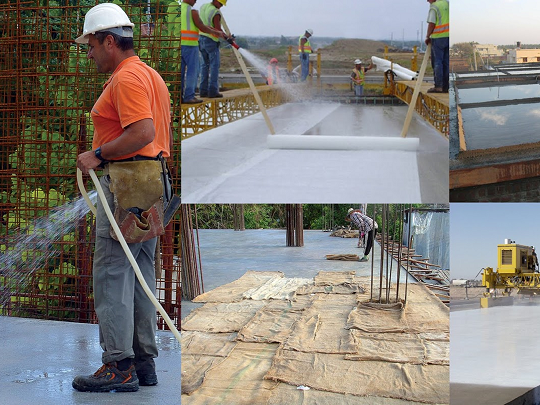
Therefore, proper curing of concrete is a must for durable and strong concrete.
Methods of Curing Concrete1.Water Curing
2.Wet Covering
3.Formwork Curing
4.Membrane Curing
5.Sheet Curing
6.Curing by Absorbing Heat
7.Hot mixing method
8.Electrical curing
9.Infra-Red Curing
10.Cover with Sand or Sawdust, Soil, etc
11.Natural Curing (Exposed concrete)
1. WATER CURING
The application of the water is done to avoid the drying of the concrete surface. Usually, this method applies when the concrete is thinner.
For example, in building construction, the curing of the floor slab can be done with this method.
There are two methods to apply the water on concrete.
Ponding the concrete
Use sprinklers to spread water continuously
Continuously wetting the concrete surface is done in the method without allowing the concrete surface to dry. Most of the time, a kerb cast around the slab helps to pond the relevant area.
This method is very useful in dry environments as it is not required to pour the water continuously. All the flat surfaces such as road pavements, slabs, footpaths, etc can cure with this method easily.
USE OF SPRINKLERSIt is a must not allowing the concrete surface getting dry due to the evaporation. Continuous spraying the water at a constant rate and uniformly is a must to fulfill the adequate curing. Sprinklers set at adequate spacing will be used for this purpose.
As indicated in the above figure, moisture level will not reduce from the required level, and this is a very easy method as it does not require lots of involvement like hand curing (cure manually).
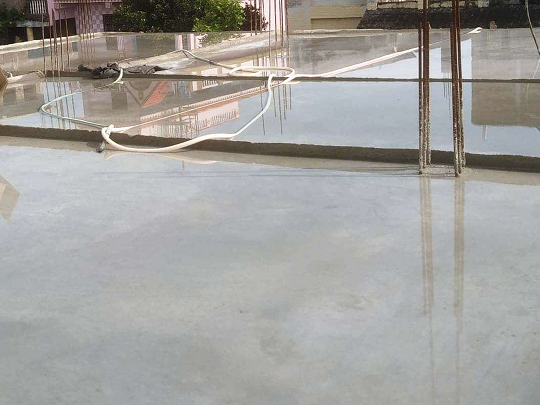
2. WET COVERING
Wet curing is a method of maintaining the surface moisture level by placing materials like hessian. Use of gunnery bae is also common.
These covering shall place on the concrete surface when it hardens enough to work to please covers. Further, the drying of the concrete surface shall not be allowed due to any reason.
The methods discussed under the title water curing can only be used to cure the horizontal surfaces. Vertical surfaces in concrete columns, walls, etc. can cure with this method as indicated in the following figure.
3. FORMWORK CURING
Formwork is the most effective curing agent in the construction. Especially in thick concretes where the hydration temperature is high, this method is used.
Further, not cost involved as the cost is already covered under the formwork. The only concern is keeping the formwork a bit longer than usual.
When the risk of cracking is becoming an issue in large concrete due to the variations in the surface of the concrete, formwork curing provides more safety.
Further, when the transmission of the heat in thick concretes are becoming an issue, formwork curing is used as an alternative. Depending on the heat, peak temperature, temperature gradient and temperature different the thickness of the formwork can be finalized.
Usually, a mockup test is done for thicker concretes when using higher grades of concrete to monitor the temperature variations. The test is done before starting the concrete work.
Depending on the outcome of the test, formwork material, its thickness, placing temperature of concrete, the measures for reducing the heat of hydration, etc are done. Generally, the test is done for the above conditions and checked whether they are acceptable.
In column curing, it is required to keep the formwork longer duration than the usual. Therefore, there may be an additional cost to the project.
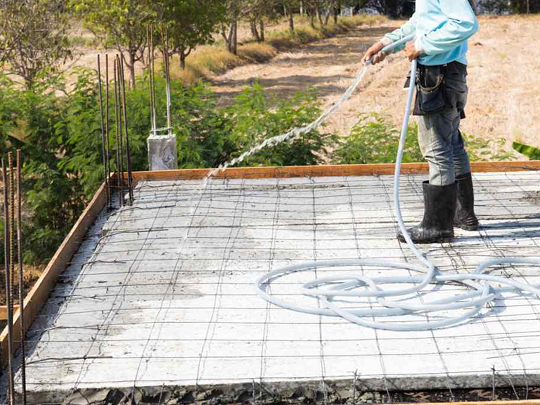
4. MEMBRANE CURING
A membrane is formed on the concrete surface to avoid the evaporation of the moisture in the concrete.
Liquid form material is sprayed over the concrete surface and it solidifies and forms a membrane. These materials can apply with brushed or roller. There are two types of membranes.
Water-based
Oil-based
The water-based curing membranes are more popular than the oil base as it can be washed off with water after the curing period, and additional effort is required to remove the oil-based membranes. Acid-etched, sandblasting or chipping is required to remove the oil base membranes.
5. SHEET CURING
There are two types of the sheet used for curing
Polythene Sheet
Plastic Sheet
Curing Blankets
Shelter areas are also created by using the polythenes in addition to applying them to the concrete. It allows the concrete to dry naturally. Special occasions less evaporation and concrete not that structurally important, this method can be used.
Both the type of the sheet are sued to cure the flat surfaces usually. Polythene sheets are sued to cover the concrete slabs and columns. The sheet can be placed on the slab just after it gets hardened.
Plastic sheets also can be used to cover the concrete. These sheets are sued to cover the flat surfaces. It is a watertight and less weight material. In addition, it is easy to handle.
In addition, curing blankets are used as protection to the newly placed concrete. It does the same thing as another type of sheet. No evaporation of moisture from the concrete surface will exist.
6. CURING BY ABSORBING HEAT – PIPE WATER COOLING
Pipes are set inside the concrete to absorb the heat. Water is circulated in the concrete and it absorbs the heat of in the concrete.
Especially for thick concrete and when a higher grade of concrete is used for construction, this method is more suitable. It reduces the core temperature.
However, these methods shall be used with much care as the sudden change in the temperature could cause cracking in the concrete.
Continuous monitoring of the temperature of the water provides an idea about the internal temperature. Base on the observations, the flow rate can be adjusted.
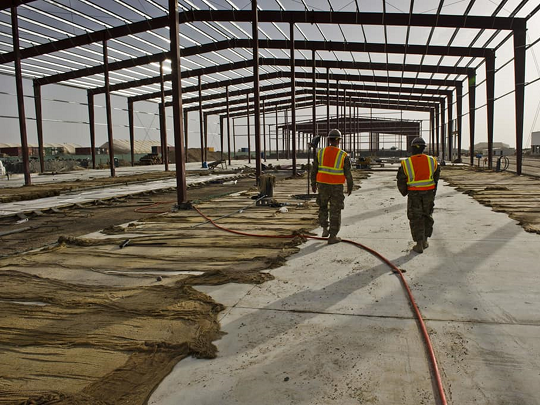
7. HOT MIXING METHOD
An increase in the temperature of the concrete is done to enhance the strength of the concrete.
Rising the temperature of the concrete up to 320C could enhance the strength by 10% – 20%.
Since the concrete gets the strength early, this method can use in a situation where it is required early strength. Further, the formwork can be removed early with the gain of the strength of early.
There are several methods that can be sued to increase the temperature of the concrete
Increase the temperature of aggregate by heating
Heat the water
Inject steam into the concrete mix
In this method, special formwork shall be used and the formwork shall also be used. This method is not typically used and it can be used on special occasions.
8. ELECTRICAL CURING
There are three methods in electrical curing.
Electrical current passes through the freshly laid concrete between two external fix electrodes. The alternate current shall be passed through the concrete. A high current having low voltage passing through the reinforcement net. Large electric blankets are utilized for the purpose of heating the slab surfaces.
9. INFRA-RED CURING
This is not a very common method and it is not widely used.
Heating of the formwork or circulating hot water inside the concrete is done.
10. COVERING WITH SAW DUST, SAND OR SOIL
This method can be employed especially in thick concrete and that has not large surface area.
Concrete surface ins pile caps, pours of raft foundations, etc. can be covered with sand, sawdust, and soil.
A membrane is placed over the concrete and sand is placed above that.
It controls the variation of the surface concrete.
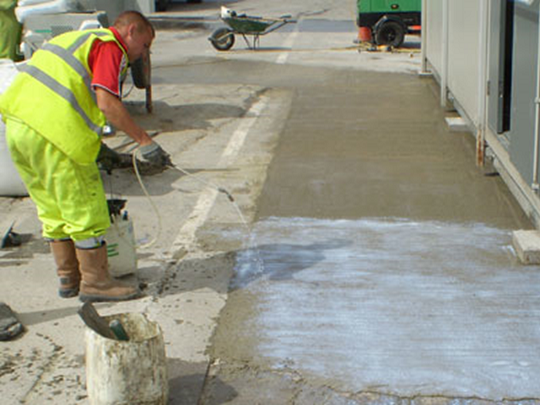
11. NATURAL CURING
Concrete is allowed to cure naturally without covering anything.
In environments where the evaporation is very less and no high heat to harm the concrete, concrete can be allowed to cure naturally.
This could mainly be done for structural elements that do not have much importance. However, structurally important elements could not be cured using this method.
Higher the rate of the evaporation, the higher the risk of cracking of the concrete. Further, the variation of the surface temperature with the time causes cracking of the concrete.
In addition, the moisture required for the hydration process is not adequate. It causes the reduction of the strength of the concrete and the same can be identified as a factor affecting the durability of concrete.
We hope you have found this blog informative and helpful. To know more about curing of concrete call us now. Feel free to share your comments and feedback with the leading builder in Chennai on hr@vvjkbuilders.com. We love it when our readers interact with us.